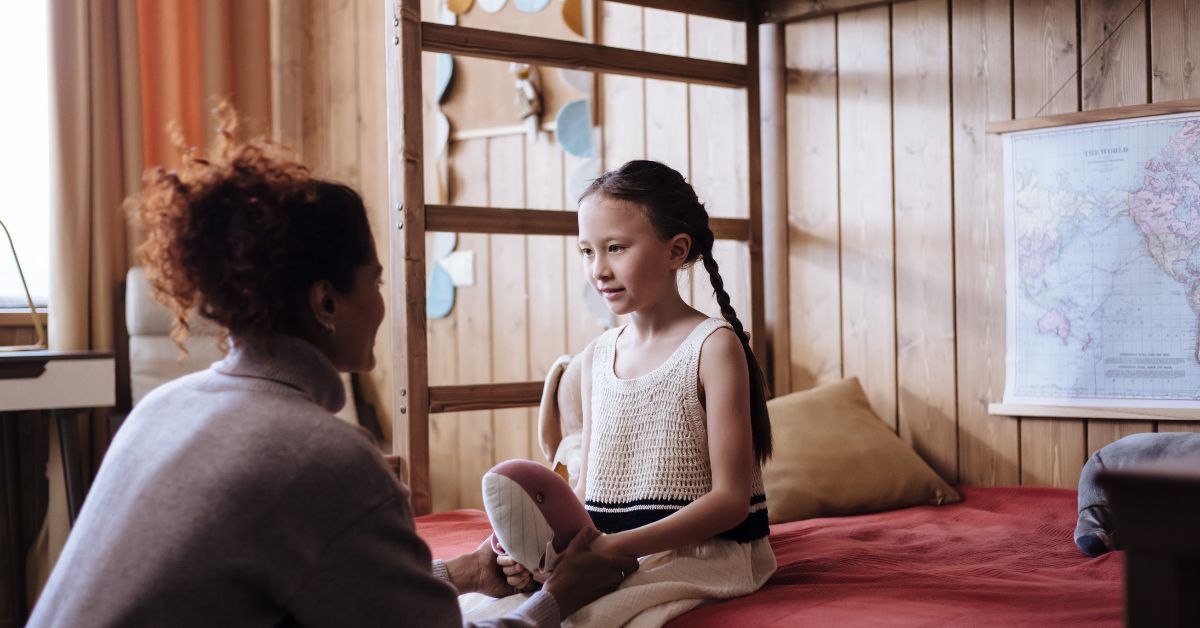We’ve all been there. You ask your child to finish their math lesson, and instead of a cheerful “Okay!” you get a sigh loud enough to register on the Richter scale, a dramatic eye-roll, or a muttered, “But this is so boring.” Suddenly, your peaceful homeschool classroom feels more like a debate stage. Dealing with a child who talks back can be frustrating, but it’s a common parenting challenge.
The key is in managing disrespectful behavior proactively and consistently, turning these moments into teachable opportunities rather than power struggles. It’s about setting boundaries and teaching respect, which are lessons just as important as any academic subject.
Why Kids Talk Back (It’s Not Always What You Think)
Before we jump into solutions, let’s play detective. Why does a child, who one minute is your sweet, curious learner, suddenly turn into a tiny, sassy lawyer? Understanding the “why” can completely change how you respond. Talking back isn’t always a calculated act of defiance. Often, it’s a clumsy attempt to communicate something they don’t have the words for yet.
Some common reasons include:
- Testing Boundaries: Children are natural scientists. They are constantly experimenting with their environment to see what happens. “If I say this, what will Mom do?” is a hypothesis they are testing. It’s a normal part of development as they figure out where the lines are drawn.
- Seeking Independence: Especially as kids get older, they crave autonomy. Talking back can be their way of saying, “I have my own thoughts and feelings!” While the delivery is off, the underlying need for independence is healthy.
- Big Emotions, Small Body: A child might be feeling overwhelmed, frustrated with a difficult school subject, tired, or hungry. They don’t have the emotional regulation skills that adults do, so those feelings can erupt as sass or disrespect. The backtalk is a symptom, not the core problem.
- Mirroring Behavior: This one can be a tough pill to swallow. Sometimes, kids talk back because they’ve seen it modeled—by older siblings, characters on TV, or even (gasp!) us. If sarcastic or dismissive tones are common in the household, children will naturally pick them up.
Understanding the root cause helps you shift from a place of frustration to one of empathy. You’re not just shutting down a behavior; you’re addressing an underlying need.
Parenting Tips For Talking Back: Your First Line Of Defense
When the sass starts flying, your immediate reaction matters. The goal is to de-escalate the situation while holding the line on respect. It’s a delicate dance, but with practice, it becomes second nature.
Here are some in-the-moment parenting tips to handle talking back:
- Stay Calm. This is rule number one, and it’s the hardest. When your child is disrespectful, it’s easy to get angry and escalate the conflict. But meeting their emotional outburst with your own just adds fuel to the fire. Take a deep breath. Your calm presence is a powerful tool that shows you are in control of yourself, which models the very behavior you want to see in them.
- Don’t Engage in the Argument. A sassy comment is an invitation to a power struggle, and it’s an invitation you should always decline. Arguing with your child gives their disrespectful behavior power and attention. Instead of debating the point, address the way they are speaking.
- Acknowledge the Feeling, Correct the Tone. You can validate their emotion without accepting the disrespect. This shows them you’re listening but that the rules of respectful communication still apply.
- Instead of: “Don’t you dare talk to me like that!”
- Try: “I can see you’re frustrated with this history lesson, but it’s not okay to speak to me in that tone. Let’s try that again respectfully.”
- Use a Simple, Go-To Phrase. Having a calm, prepared response can prevent you from reacting emotionally. Find a phrase that works for you and use it consistently.
- “We don’t speak to each other that way in this family.”
- “I will be happy to listen once you can speak to me respectfully.”
- “That sounded disrespectful. Please rephrase it.”
- This isn’t about getting an immediate apology. It’s about drawing a clear, calm boundary.

Setting The Stage For Respect In A Homeschool Environment
One of the unique aspects of homeschooling is that you are both parent and teacher. This can sometimes blur the lines, but it also gives you a fantastic opportunity to intentionally cultivate an environment of respect. You’re not just correcting backtalk; you’re building a family and learning culture where it’s less likely to happen in the first place.
Think of it as proactive classroom management, but your classroom is your home. This means being clear about expectations before an issue arises. A family meeting at the start of a school year or semester is a great time to establish “Classroom Rules” together. When children have a hand in creating the rules, they have more buy-in. Frame it positively. Instead of “No talking back,” try “We speak to each other with kindness and respect.” This sets a standard for everyone in the home, adults included.
Modeling is also incredibly powerful. How do you and your partner speak to each other when you disagree? How do you speak to your children? They are always watching and learning. Use “please” and “thank you.” Apologize when you make a mistake. When you need to correct your child, try to do it privately rather than in front of their siblings to avoid shame, which can breed resentment and more acting out. Creating this foundation of mutual respect makes disrespectful behavior stand out as something that just doesn’t fit in your family culture.
Effective Discipline Strategies For Homeschoolers
When you’ve calmly corrected in the moment and the disrespectful behavior continues, it’s time for a clear consequence. Discipline isn’t about punishment; it’s about teaching. In a homeschool setting, discipline can be directly and logically tied to the situation.
Managing Disrespectful Behavior with Clear Consequences
The most effective consequences are immediate, logical, and related to the misbehavior. This helps your child connect their action with the outcome. Here are some strategies that work well for homeschoolers:
- Loss of Privileges: This is a classic for a reason. The privilege lost should be something the child values and, ideally, related to the time of the infraction. If they are being disrespectful during school hours, the consequence could be the loss of screen time or playtime that afternoon. “Because we spent extra time discussing your tone, there isn’t enough time for video games after your lessons are done.”
- The “Respect Rewind”: Ask your child to pause and try the conversation again. “Let’s rewind. How could you have told me you were feeling frustrated without using that tone?” This is less of a punishment and more of a practical lesson in communication. It gives them a chance to self-correct in a low-stakes way.
- Time-In or Cool-Down Corner: Instead of a punitive “time-out,” consider a “time-in.” This means having the child sit with you or nearby to cool down. It sends the message, “I don’t like your behavior, but I still love you and want you near me.” For older kids, a designated “cool-down corner” where they can go to regulate their emotions can be effective. It’s not a punishment, but a tool they can use.
- Logical Consequences Tied to Schoolwork: If the backtalk is directly related to a school assignment, tie the consequence to it. For example, if they refuse to do an assignment respectfully, the new rule might be that all schoolwork must be completed before any fun activities can begin. This naturally links their choices about school with their free time.
Remember to follow through. Consistency is your best friend. If you set a consequence, you must enforce it every time. If you don’t, you teach your child that the boundaries are negotiable and that they just need to push a little harder next time.
Beyond The Backtalk: Building A Stronger Connection
Often, a chronic issue with talking back is a sign that something bigger is at play. It might be a signal that your child is feeling disconnected from you. In the busy world of homeschooling, it’s easy to get so caught up in lesson plans and curriculum that we forget to simply connect with our kids on a human level. Taking time for connection isn’t a “soft” strategy; it’s one of the most powerful tools you have for managing disrespectful behavior.
When a child feels seen, heard, and valued, they are far less likely to act out for attention or control. Spend one-on-one time with each child, doing something they love, with no agenda other than to enjoy their company. It doesn’t have to be a big outing. It can be 15 minutes of building with LEGOs, shooting hoops in the driveway, or just chatting before bed. This deposits positive feelings into your relational bank account, which you can draw upon when times get tough. A strong connection builds a foundation of love and trust that makes discipline feel like guidance rather than punishment.
Find More Homeschooling Resources
Parenting and teaching are two of the most demanding jobs in the world, and you’re doing both. Give yourself grace. You won’t handle every eye-roll and sassy comment perfectly, and that’s okay. The goal is progress, not perfection. By staying calm, setting firm but loving boundaries, and prioritizing connection, you can turn these challenging moments into lessons that will serve your child for a lifetime.
For more practical advice, curriculum reviews, and encouragement on your homeschooling journey, be sure to explore more articles on the DKM Homeschool Resource blog. We’re here to support you every step of the way.




